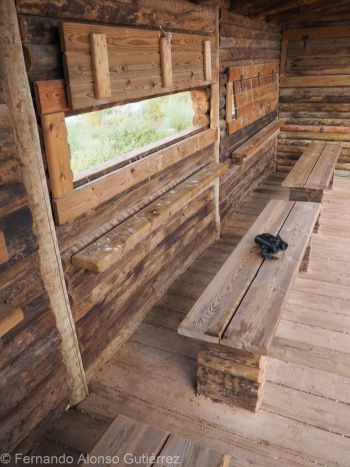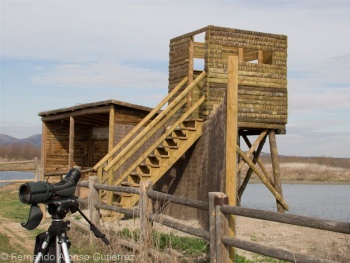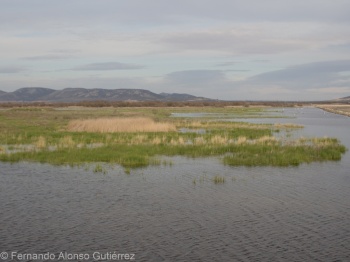Overview
Included in La Mancha wetlands, a large cluster of shallow wetlands associated to the Western Mancha aquifer located in the corner formed by the provinces of Ciudad Real, Cuenca and Toledo, about 150 km SW from Madrid.
Lagunas de Alcázar complex is made up of three consecutive shallow lakes or lagunas extending for about five kilometres between Alcázar de San Juan and Villafranca de los Caballeros. The closest to Alcázar town is Laguna de La Veguilla, which usually is the hotspot for the whole area (specially if Laguna de Manjavacas and Laguna de Pedro Muñoz are both dry or with low water levels). Downstream and further away of the town we find Laguna del Camino de Villafranca and finally Laguna de las Yeguas.
In origin all these were endorheic steppe lakes, but have been heavily modified both by agriculture and urban pressure. The degree and extent of inundation changes from year to year. In an average year you can expect to find them dry from late July until October. The input of the treated sewage of the town of Alcázar has modified this character, mainly in the case of Laguna de La Veguilla, making it more permanent (even all year round), less saline and more eutrophic. As a consequence a fringe of Phragmites reeds has developed all around it. Some years La Veguilla is managed to dry out in order to to avoid botulism risks. In the other lakes the steppe-like conditions leading to hypersaline environment are more evident, with adjacent prairies of Salicornia ramosissima, Salsola soda, Suaeda sp and several Limonium sp. Conditions are more extreme in Laguna de Las Yeguas, which usually dries out all the summer and autumn.
Near Alcázar another distinct type of wetland, riverine flood areas, is also found. "La Junta de los Ríos" (that is, the confluence of rivers Cigüela and Záncara) is more similar to the renowned Tablas de Daimiel National Park in its original driving processes. However, surface flows have suffered heavily from water abstraction for irrigation in the area, and nowadays river Záncara doesn’t flow at all for most of the year. Works to restore this wetland are in progress within a LIFE project, with promising results, although the original functionality is yet to be recovered.
All these wetlands are set within an agricultural landscape of vineyards, olive trees and some irrigation fields that still maintain drier steppe-like areas which hold a healthy population of specialists birds.
Lagunas de Alcázar is both Natura 2000 and RAMSAR sites.
Birds
Notable Species
Designation as RAMSAR site was awarded due to its importance for breeding/numbers for Pied Avocet, Black-winged Stilt and Gull-billed Tern.
Several hundreds of Greater Flamingo move all year round (if the water levels allow) between Lagunas de Alcázar and the nearby Laguna de Manjavacas and Laguna de Pedro Muñoz: they are usually seen both at Laguna de La Veguilla and Laguna del Camino de Las Yeguas. Sometimes an odd Lesser Flamingo joins the flocks. White-headed Duck breeds in the area and can be seen during all year at La Veguilla, the second being the best place for watching them closely, as happens also with Western Swamphen. Other breeders are Red-crested Pochard and Black-necked Grebe. Little Grebe is another common species. Ferruginous Duck is an occasional breeder at La Veguilla. At Laguna del Camino de Villafranca there is a breeding colony of Black-headed Gull with occasional nesting of Mediterranean Gull.
The reedbeds hold among other warblers Savi's Warbler and Cetti's Warbler, as well as Bearded Tit. Penduline Tit and Reed Bunting are also present, as does Bluethroat during winter.
During winter good numbers of wildfowl Northern Shoveler, Gadwall, Mallard, Common Teal, Common Shelduck, Common Pochard and Eurasian Coot and, to a lesser extent Greylag Goose arrive. Eurasian Wigeon and Northern Pintail are scarcer but common visitors. La Veguilla always hide some surprise, so an eye should be kept on rarities hidden between the more common species flocks. Small numbers of Garganey can be seen during spring.
A large dumpsite about 4 km away contributes with a colony of several thousands of Lesser Black-backed Gull, with some Yellow-legged Gull and the occasional rarity in between. A large number of White Stork can be seen all year round roosting at Laguna de La Veguilla
Waders on passage including Pied Avocet, Ruff, Black-tailed Godwit, Dunlin, Little Stint, Common Redshank, Common Greenshank, Common Snipe and also some Wood Sandpiper, Spotted Redshank and the occasional Curlew Sandpiper, Sanderling or even Temminck's Stint. Only at the right levels of water they can be seen well from La Veguilla hides, the best options being usually the Laguna del Camino de Villafranca and Junta de los Ríos, where also both Ringed Plover, Little Ringed Plover and Kentish Plover are common. In early summer both Black Tern and Whiskered Tern can be seen, as does Collared Pratincole.
Raptors include a healthy population of Marsh Harrier, with of over one hundred individuals roosting and breeding. Summer visitors frequently seen include Black Kite and Booted Eagle.
These wetlands are set within an agricultural landscape of vineyards, olive trees and some irrigation fields that still maintain drier steppe-like areas. Not far from Alcázar, near the road to Miguel Esteban is the hypersaline Laguna del Salicor, usually dry but with a very well preserved steppe area around it which deserves a look for Great Bustard,Little Bustard, Pin-tailed Sandgrouse, Stone-curlew, Lesser Kestrel, Greater Short-toed Lark, Western Black-eared Wheatear and, during winter Common Crane that may be feeding in the area of Laguna del Salicor. Eurasian Dotterel, with most of the above mentioned species, are seen regularly during autumn/winter in the dirt track (Camino Guerra) leading to Junta de los Ríos (which see). Check also for Collared Pratincole near Junta de los Ríos.
Check-list
Little Grebe, Great Crested Grebe, Black-necked Grebe, Great Cormorant, Little Bittern, Western Cattle Egret, Little Egret, Squacco Heron, Purple Heron, Grey Heron, White Stork, Greylag Goose, Common Shelduck, Eurasian Wigeon, Gadwall, Common Teal, Mallard, Northern Pintail, Garganey, Northern Shoveler, Red-crested Pochard, Common Pochard, Ferruginous Duck, Tufted Duck, White-headed Duck, European Honey Buzzard, Black Kite, Short-toed Eagle, Western Marsh Harrier, Hen Harrier, Montagu's Harrier, Common Buzzard, Booted Eagle, Lesser Kestrel, Common Kestrel, Sparrowhawk, Peregrine Falcon, Red-legged Partridge, Water Rail, Spotted Crake, Common Moorhen, Western Swamphen, Greater Flamingo, Lesser Flamingo, Eurasian Coot, Little Bustard, Great Bustard, Common Crane, Pied Avocet, Black-winged Stilt, Stone-curlew, Collared Pratincole, Common Ringed Plover, Little Ringed Plover, Kentish Plover, European Golden Plover, Eurasian Dotterel, Northern Lapwing, Dunlin, Ruff, Red Knot, Sanderling, Little Stint, Curlew Sandpiper, Temminck's Stint, Common Snipe, Jack Snipe, Green Sandpiper, Wood Sandpiper Common Sandpiper Black-tailed Godwit, Bar-tailed Godwit, Eurasian Curlew, Common Redshank, Common Greenshank, Spotted Redshank, Black-headed Gull, Lesser Black-backed Gull, Yellow-legged Gull, Gull-billed Tern, Whiskered Tern, Black Tern, Pin-tailed Sandgrouse, European Turtle Dove, Eurasian Collared Dove, Common Wood Pigeon, Great Spotted Cuckoo, Common Cuckoo, Eurasian Scops Owl, Little Owl, European Bee-eater, Eurasian Hoopoe, Calandra Lark, Crested Lark, Greater Short-toed Lark, Barn Swallow, Water Pipit, Meadow Pipit, Western Yellow Wagtail, White Wagtail, Bluethroat, Cetti's Warbler, Savi's Warbler, Zitting Cisticola, Sedge Warbler, Common Reed Warbler, Great Reed Warbler, Willow Warbler, Common Chiffchaff, Bearded Tit, Penduline Tit, Iberian Grey Shrike, Common Starling, Western Black-eared Wheatear, Eurasian Tree Sparrow, Spanish Sparrow, European Greenfinch, European Serin, Common Linnet, Corn Bunting, Reed Bunting
Other Wildlife
Rabbit is very abundant where Tamarix surrounds the lakes.
Site information
History and Use
Land occupation goes back as far as the motillas, hill-shaped settlement remains from the Bronze Age, with a good example (Motilla de los Romeros) not far from Alcázar. As in most of Spain, there is also abundant Roman archaeological evidence.
At Alcázar itself the remains of the Torreón del Gran Prior (XIIIth century) show today the links of the village with the Order of Malta - which established in this area about that time. In fact, Alcázar takes its name both from the Arabian Al Qasr (the castle) and from one of the other of the names of the order of Malta, St. John (San Juan) of Jerusalem. Its socio-economical influence, together with the opening of the main Spanish gunpowder industry at the time (XVIth century) led to an economic bonanza which lasted until the XIXth century, when the town economy declined until the arrival of the railway in 1870's.
Problems with water abstraction also arrived with the railway, and La Veguilla became both the dumpsite and recipient of the town wastes, leading to the spread of illnesses among the citizens. This severe damage persisted until 1990’s when the first protection measures were implemented.
From the 1950’s onwards the development of agriculture led to the channelization of the main rivers, including Záncara and Cigüela, the drainage of the smaller lagunas and the overexploitation of the aquifer for irrigation, which finally led to the loss of most of the original inundation plains (over 3,500 Has only in the confluence of Záncara and Cigüela), affecting severely to the other neighbouring wetlands.
In 1999 the three lakes were protected under Nature Reserve category. Since then conservation measures have been undertaken, including the sewage treatment plant for the town. In 2012 work started at “Junta de los Ríos” to recover part of the original wetland area.
The wetlands were historically important in the local economy, as the saltpeter used the blackpowder industry came from them. Also important was tumbleweed Salsola soda, employed at that time for soap elaboration due to its alkaline content. Reeds and rushes were also collected for use. Nowadays its recreational use is becoming more important, not only birdwatching but also cycling or walking around them.
Areas of Interest
You can see the famous “giants” against whom D. Quixote battled in thoughts, that is, the windmills dominating the landscape of Alcázar and the nearby Campo de Criptana, for example.
Exploring the whole wetland and its surrounding steppe areas can easily take a whole day (or even two!) but if desired a visit to other nearby one such as Lagunas de Villafranca, Laguna de Pedro Muñoz or Charcones de Miguel Esteban is a possibility. For a weekend the not so far Laguna de Navaseca and Tablas de Daimiel National Park combo can be included.
Not far away (70 km) you can also visit Lagunas de Ruidera, a sequence of fourteen beautiful, deeper karstic lakes.
Access and Facilities
Alcázar de San Juan is by the CM-42 highway and the national road, N-420 goes through the town, making access easy by car from Madrid in about 1h 30 min. Is also linked by railway to Madrid, Albacete, Ciudad Real and Jaén.
Laguna de La Veguilla has three hides accessed by the first dirt track on the right as you take the road CM-400 from Alcázar de San Juan to Villafranca de los Caballeros, about 300 m after exiting the roundabout (39.390421, -3.238388). The first one gives the best views to the open lake, the second one and third to a sheltered area among the reedbeds, with closer views to some of the interesting species, as White-headed Duck. Side by side to the third hide there is a interpretation centre, which has been closed for the last four years due to budget cuttings (latest info march 2016). There is also a wooden tower but is closed to public. The other two lakes, Laguna del Camino de Villafranca and Laguna de Las Yeguas (usually dry) are reached via a dirt track which starts (39.390421, -3.238388) near the big rusty-coloured building visible from La Veguilla and follows through the edge of a small pine stand before reaching Laguna del Camino de Villafranca. Avoid access to La Veguilla hides from this entrance although signposted because it leads to a frequently closed gate (!) Alongside Laguna del Camino de Villafranca there are three small hides and a bigger one (again closed!) in front of the island used by gulls for breeding on wet years. From here onwards the track becomes tricky after rain.
To reach the Junta de los Ríos we leave Alcázar towards Manzanares by CM-3107 road, near the cemetery. Just after crossing over the highway CM-42 a wide track signposted “Camino Guerra” leaves the roundabout to the right of the road (39.368786, -3.216363). Following it for about 8 km we reach a stone bridge over the (usually) dry river Záncara (39.314002, -3.268206), most time driving through prime quality steppe habitat. Without crossing it the track skips to the right besides a “cortijo” (farmhouse) with a Lesser Kestrel colony. It takes another 2 km to reach the car parking at Junta de los Ríos (39.317231, -3.291311). There are main two hides joined by a footpath of 1’5 km. New hides and information panels have been set up in the area.
Laguna del Salicor is found near the road CM-310 to Miguel Esteban. Drive for 7 km from Alcázar to find the wide track to the left (39.441593, -3.145487) that leads to it.
Access to all these areas is open and free.
Although binoculars could be enough in the second and third hides at La Veguilla, a scope is invaluable for all the other areas.
Accommodation is readily available at Alcázar de San Juan and there are plenty of restaurants and bars in the town. You have also a commercial centre near the road to Villafranca.
Contact Details
The Visitor's Centre is managed by the city council of Alcázar Info Phone number: +(926) 550005
External Links
Content and images originally posted by Fernando Alonso (fdokykcu)
Reviews
History







